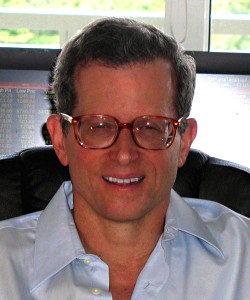Michael Marcus – Blighting doesn’t strike twice – Investor Profile

This article is part of our ‘Guru’ series – investor profiles of those who have succeeded in the markets, with takeaways for the private investor in the UK.
You can find the rest of the series here.
Contents
Michael Marcus
Michael Marcus began his career as a commodity research analyst, but became addicted to trading.
After failing as a floor trader he moved to Commodities Corporation, a firm that hired traders to use the company’s funds.
He was one of their most successful traders, multiplying his account by 2,500 times over 10 years.
Blighting doesn’t strike twice
Marcus was interviewed by Jack Schwager for his original Market Wizards book. His chapter is called Blighting doesn’t strike twice (we’ll see why later).
Marcus is the first chapter in the first book of Schwager’s series. It was the first interview with a successful trader that I ever read, and is the inspiration for this Guru series of articles.
A bad start
Michael Marcus was a good student and expected to become a professor. When an acquaintance promised to double his money in the commodity markets, he fell for it.
By the time he realised the guy knew nothing – and Marcus was out of money – he was hooked. He raised another trading stake and lost this one himself. All his first 8 trades lost money.
He cashed in his late father’s life insurance and started to trade wheat and soybeans from a market letter. He started to make winning trades.
His first piece of luck came in 1970 when he was long corn when blight devastated the crop. His portfolio was up by 10 times by the end of the summer, to $30K.
At graduate school, he began cutting classes to trade, then dropped out to move to New York.
In spring 1971 Marcus became convinced that the corn blight would strike again and borrowed another $20K from his mother. He put it all on corn.
But there was no blight, and the corn market went limit down. Marcus sold the next day, losing $42K of his $50K on one trade.
He went to work as a commodity analyst.
Mentors
In this job he was forbidden to trade, but did so anyway, borrowing more from his mother, brother and girlfriend. He lost.
Then he met Ed Seykota, an MIT graduate looking at computer-driven trading. ((We’ll be looking at Ed in a later article ))
Marcus was hired by Ed’s firm and learned a lot about trend following from Ed. Most important was cut your losses and ride winners.
But Marcus himself was still not patient enough to wait for a good trend. He found another mentor in Amos Hostetter, and slowly his trading improved.
Price controls
By 1972 he had a shared $700 trading account with a sleeping partner.
Commodities were under price controls. Plywood was frozen at $110 per 1,000 square feet. But one day the futures market closed above $110.
Marcus realised that “if they let it trade over $110, they might let it trade anywhere.” He started to buy plywood, and it went to $200. The trading account went to $12K.
He saw the same thing happening in lumber and went all in. Then the government announced a crackdown on lumber speculators.
The market crashed and Marcus was almost wiped out again, though the price only fell from $130 to $117. He was left with less than $4K.
This was the last time he bet everything on a single trade.
Eventually, the market recovered and he turned the $4k back into $24K by the end of the year.
Bull market mistake
In 1973 the US government started lifting price controls and “just about everything went up”. His account went from $24K to $64K that year.
Marcus made one bull market mistake though, which made a greater impression on him.
“Trying to be fancy”, he got out of soybeans and watched as the market went limit up for 12 days in a row. His friend Ed Seykota was fully invested, and Marcus found it agonising to watch him make money.
He describes this as the low point in his trading career.
The cotton exchange
Marcus had visited the Cotton Exchange and liked the adrenaline rush. But he needed $100K to trade there. Eventually, he had it.
The catalyst for his move was the opposite of the soybean trade.
He went long coffee on the advice of Ed, but the market turned and he was quickly stopped out. But Ed had no stop and was locked in as the market traded limit down for several days.
Marcus found that he couldn’t help but enjoy his friend losing money.
He decided that what he was doing was too competitive, and came to the bizarre conclusion that it would be better to be a floor trader at the cotton exchange.
He was ill-suited to this. Very shy, he ended up getting another floor trader to execute his trades.
He learned how to read the market through the noise on the floor, but he wasn’t a success.
Trading style
On the floor, he started to trade “intraday chart points” – things like earlier daily highs. If such a resistance level was broken, the market would either run away of he would be stopped out cheaply.
Marcus felt that by the time of the interview (1988), markets had become too choppy – there were more pullbacks – for this to work.
He now prefers to make fewer trades, waiting for three things to line up:
- fundamentals (in commodities, supply & demand)
- technicals
- market tone (the right reaction to news flow)
He found sticking to this approach difficult, and compromised by using much larger positions (5-6 times) in the conviction trades as in his “fun” trades.
All his money was made in the conviction trades, with the fun trades just breaking even.
Marcus uses EPS growth as an indicator for stocks, along with PE. (This sounds a lot like Jim Slater’s PEG ratio.) He doesn’t use relative strength because it tells you what a stock has already done.
What has changed?
Marcus believes there are fewer conviction trades than in the past because markets have become more sophisticated. There are more professional and institutional traders and fewer dentists.
Marcus also believes there are now many more false breakouts. This makes trend-following much harder unless there is a major market imbalance, or serious inflation/deflation.
When everyone is aware of the trend, they all take positions at the same time, and then there is no-one left to buy. So the market swings back.
In the currency markets, the increasing role of central banks has led to fewer good trends. Marcus used to be a large trader of currencies but has pulled back.
Commodities
When he left the Cotton Exchange, Amos Hostetter got him a job at Commodities Corporation.
They were hiring econometricians and were disappointed that Marcus had no PhD. The joke was that “he just trades.”
He started with $30K in 1974 and turned it into $80M in 10 years. $100K was added after a few years, but in later years 30% a year was withdrawn by the Corporation for “expenses”.
Marcus made “at least 100% a year for years and years”.
He traded gold for a long time and then became an expert in cocoa.
Helmut Weymar – the founder of Commodities Corporation – was an expert on cocoa, but Marcus was better at trading from his information. But when Weymar retired, Marcus stopped trading cocoa.
The rest I squandered
Marcus made a lot of money trading, but he wasted most of it.
He owned ten houses and lost money on all of them. He also owned planes.
Outside of investing, he always acted emotionally and never analyzed anything. If any of his staff – he was employing 60+ people at this point – tried to stop him, he would fire them.
On the plus side, Marcus say that he treats the losses as a life lesson, to not be as attached to material things. With houses and planes, rent not buy.
Trading Rules
Marcus believes that to be a great trader requires a gift – like being a great violinist – but that most people can learn to be a successful (money-making) trader.
- Always bet less than 5% of your money on a single idea; that way you can be wrong twenty times in a row.
- Commit to an exit point on every trade.
- Use physical stops – protective stops force commitment on the trader.
- Get out as soon as a position doesn’t feel right.
- Hold on to your winners and cut your losers.
- Follow your own light. Marcus knows many talented traders, but if he tries to trade their way, or trade their ideas, he loses money.
- Focus on the best trades, when fundamentals, technicals and market tone line up.
- Don’t rely on “experts”. You have to do your own homework.
- There is no conspiracy in the markets.
- Be objective and open-minded. A good trader can’t be rigid.
- Find a balance in life – have fun and another focus outside trading.
- When you hit a losing streak, cut back your trading.
- Marcus himself finds this rule hard to follow – he often “fights back” with more trades at first, then retreats after a second defeat.
- Marcus often plots his daily equity, using a downtrend as an indicator that he should cut back.
- If possible, stop for three or four weeks.
Quotes
While you are in, you can’t think. When you get out, then you can think clearly again. Have a good night’s sleep and get back in if you want to.
Mix and match often leads to picking the worst from each approach. If you are in someone else’s trade you won’t have the courage to stick with it.
The average broker couldn’t be a trader in a million years.
When I was trading big, I wanted to have a reason to keep doing it, so I just spent money wildly.
Ninety-nine percent of the time, the market goes where it wants. There are exceptions, but they don’t last too long.
You can’t trade 13 hours a day for 20 years. You will end up over-trading or getting too upset about temporary setbacks.
Losing begets losing … it touches off negative elements in your psychology; it leads to pessimism.
Conclusions
Marcus’ story certainly drives home the point that early setbacks can be overcome.
I think that he was lucky to trade through the 1970s inflationary commodities boom and in particular the end of price controls. He was also lucky to have great mentors to learn from.
But his trading rules, whilst mostly familiar, stack up even today.
And his behaviour away from the markets is equally instructive in the opposite sense.
Until next time.




















